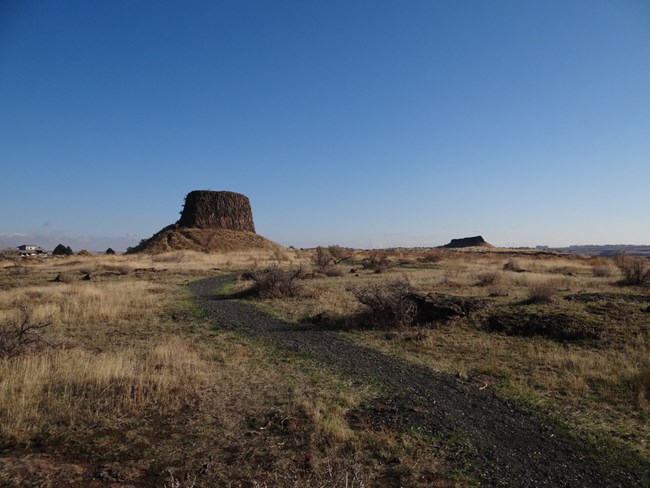Part of a series of articles titled Tourism Stories.
Article
Supporting Communities Along the Trail

While the National Park Service is best known for managing national parks, the agency also works with communities and other partners to administer a series of expansive scenic and historic trails traversing thousands of miles. One of the longest, the Lewis and Clark National Historic Trail, commemorates the famous 19th century Corps of Discovery Expedition. Only five of the 100+ sites along the trail are NPS units, so staff managing the trail, in the same spirit of adventure as those early explorers, continue a new type of expedition, working creatively with communities to connect travelers to this story of discovery and the impact it had on Native Americans and the settlers that followed.
Although the Lewis and Clark story is well-known, not everyone is aware of the commemorative trail. Spanning land and water across eleven states, the trail serves as a reminder of westward expansion in America. National Park Service staff manage a variety of creative programs and partnerships to connect travelers, residents, communities, and local businesses to the heritage of the Corps of Discovery. One unique program underway is a geotourism project developed in collaboration with the tourism management firm Solimar International.
Geotourism is a concept first coined by National Geographic referring to tourism that sustains or enhances the distinct geographical character of a place, including its environment, heritage, aesthetics, culture, and community well-being. The geotourism model, similar to the National Heritage Area model, encourages communities and small-businesses to leverage, promote, and sustain the distinctive heritage and character of an area.
For the Lewis and Clark project, Solimar convened a Stewardship Council composed of local stakeholders, residents, other land management agencies, and business owners to develop business and marketing plans that express the unique character of the communities and the project themes. Businesses and communities wishing to participate apply via an online portal and can ultimately add their business, service, or experience to a trail map, unifying communities around their shared heritage.
While communities along the trail are linked through their connection to the expedition and its aftermath, the trail spans a diverse array of landscapes, communities, and even jurisdictions. Visitor centers are key locations for promoting the trail, so NPS staff work with local tourism organizations and other federal agencies that manage visitor centers along the route. These visitor centers provide the backbone for locally-focused interpretation and visitation information, telling the story of the expedition in that area along with promoting tourism and recreation opportunities.
To attract and engage the public, trail staff compliment tourism activities in communities with NPS-sponsored programs and activities. Through partnerships with visitor centers and other federal, private and non-profit partners, unique events and campaigns rooted in the exploratory spirit of Lewis and Clark draw attention to the trail.
Partnering with NASA and United States Geological Survey (USGS), the Lewis and Clark trail sent toy replicas of Lewis and Clark’s dogs along the trail and even to outer space! Photos and satellite images of this event helped build a trail map, stitching together the journey from a new perspective. The stuffed pups have a blog and are featured on social media so that visitors and spectators are encouraged to follow their journey.
In 2018 the trail hosted the American Solar Challenge. Teams competed as they raced their solar cars from park headquarters in Omaha, Nebraska to the trail’s end as a modern day expedition.
The National Park Service also amplifies the voices of those present before, during, and after the famous expedition. During the 2003-2006 bicentennial commemoration of the expedition, known as the Corps of Discovery II, over 400 Native Americans shared their stories, art, music, and history in a traveling classroom to broadcast awareness of Native contributions to the Lewis and Clark expedition and to highlight the heritage of today’s existing, vibrant Native communities. Tribal tourism products and experiences available to travelers are being included in the geotourism project, ensuring that the Native perspective is integrated into the experience of travelers exploring the trail today.
The geotourism project is a valuable strategy for maintaining community engagement with NPS around the trail. While special events like the Corps II are useful for instigating increased community engagement, events and anniversaries come and go. NPS Chief of Integrated Resource Stewardship Dan Wiley notes that the ongoing geotourism project provides a catalyst to maintain ongoing collaboration, bringing together stakeholders to leverage the trail for tourism promotion and economic vitality.
Chief Wiley sums up the complex nature of managing tourism within the National Park Service, especially in a unit that directly manages very little of its footprint, by stating, “today, visitation and engagement with national parks comes in many forms. Using tourism to attract visitors is ideal because the more people that see and visit the resources, the more people appreciate them, as long as we recognize and respect carrying capacities”. Through tourism-focused collaboration, the Lewis and Clark National Historic Trail staff support active engagement with the trail and with the communities where the history lives on.
Last updated: April 26, 2019
